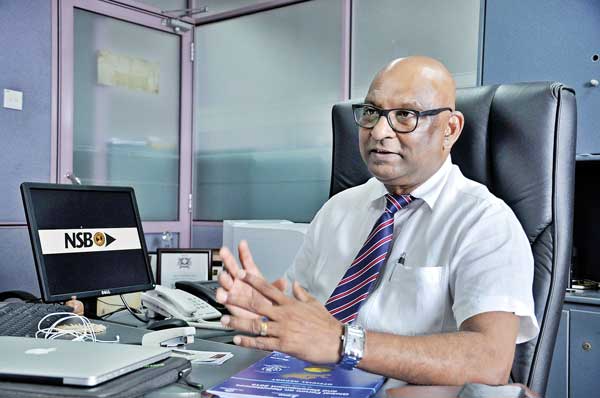Reply To:
Name - Reply Comment

Chandula Abeywickrama
 By Supun Dias
By Supun Dias
First of all, why is the International Day of Family Remittance is so important for the country’s largest savings bank?
This is the first time it was proposed by the International Fund for Agricultural Development (IFAD), a UN affiliated agency. The day is an invaluable opportunity not only to recognize the efforts of migrant workers globally. As a result of this, people from Asian countries go to developed countries as workers, where 250 million migrant workers remitting US $ 400 billion annually.
They go as individuals and leave their families behind for economic reasons. But it’s a huge sacrifice they make. The most focused area is, they think about the social and economic development of the family. After three to five years they come back. As a result of this, thousands of children are educated; thousands of houses are built and renovated; thousands of micro businesses come up.
But most of them are unable to find the same revenue here. So the focus is, there should be adequate revenue to support his/her life here. The day ensures that the family is enriched socially, culturally and economically. The day is important as it enables to strengthen the current partnerships and create new synergies among sectors to promote the development impact of remittances worldwide.
How has the global economic slowdown and the sharp drop of commodity prices affected the remittance market as a whole?
There are migrant worker corridors. Eastern Europeans go to Western Europe; Asians go to Europe, Far East and Middle East. There is an economic downturn in Europe and the Middle East corridor countries will be affected. But countries like Qatar will keep improving. There is a transition from blue-collar workers to white-collar workers (skilled employees). But there are new corridors opened up for Sri Lankans in countries such as South Korea, Malaysia, Singapore and Japan. These countries will give us high-value remittances.
We will continue to have the US $ 7 billion annually but you would see these transitions taking place gradually within few years. If you look at countries like Bangladesh, there is a significant opportunity for skilled Sri Lankans. Also countries such as Myanmar, which has opened up recently, Sri Lankans have a huge demand. Remittance business would expand globally. We have to plan this out strategically as the talent move will take place. So I don’t think we will be affected much since we are a small country. Though 10 percent of our population is migrant workers, it’s still a small fraction when you take the global migrant workforce. But the construction field will have some setbacks in the Middle East and that may affect the migrant workers there.
What sort of steps has NSB taken to face this situation as it is our largest foreign exchange earner?
We are the only AAA-rated bank and we have 100 percent state guarantee. See, it will be replenished with the transition from blue-collar jobs to white-collar jobs.
Our focus is to provide them with the best services available. What we are focusing is not only the remittance side. There is lot of specialized remittance agencies. Here the person who remits money has a relationship with the bank and we ensure that his family benefits from a wide range of financial services provided by us.
Can you share with us some of the initiatives taken by NSB to capture the remittance market? We have heard that still there are lot of people who send remits through illegal channels.
We have recognized the importance of this segment and we are a national bank so we have national priorities. We have to look after particularly the rural people. One third of the population is taken care of by the migrant workers. We feel as a bank that it is our responsibility to be there for Sri Lankans to provide the service. Though we are a savings bank, we want to bring in financial services by strengthening our correspondence network and delivery mechanisms in Europe, South Korea and the Middle East. We have now branded our service as NSB – U TRUST.
People trust NSB. Still for rural people it is the bank they can trust and be dependent upon. We have 250 branches and as we have linked with the Postal Department, with an additional 650 post offices, we have been able to create the largest network with the greatest accessibility for migrant workers and their dependents. We have made other financial services available for them as well in the meantime.
How can we use foreign remittance towards the country’s development process?
Remittance flows have a substantial positive impact and contribute significantly to several key development priorities through new partnerships, improved public policies and scaled-up innovations. To a greater extend, our economy is powered by this sector. However, they are not represented by a migrant worker association. So they don’t have a lobbying body to have greater facilities for these people. Economic development with their contribution has to come from micro level.
Other than a savings account or a fixed deposit, there is no other platform for the migrant worker to invest. Every migrant worker won’t have the entrepreneurial skills, but he would want to invest. There has to be some sort of guidance towards providing them with investment opportunities in areas such as agriculture, tourism, hospitality and healthcare.
Under your leadership what are the new steps that has been taken to increase the number of customers in this market and how do you plan to expand?
Our plan is to ensure that there is a next generation of customers, the younger generation. They need to be a crucial part of this sector. But they would want our services mostly on a digital platform. Customer expansion has to go in two ways. One is the barefoot level banking and the other is banking for the next generation, the tech-savvy generation. Barefoot banking needs more link points and we do not want to go 100 percent on tech. We still have only about five million smartphones, the rest are yet to be linked digitally for such services/platforms. So we have to cater to them as well and to have a more pragmatic approach as we want to build and have relationships that would ensure that the people are enriched economically as saving is the initiative of the asset creation.
Finally, how optimistic are you about the remittance market in Sri Lanka?
It would continue to grow significantly. We are a skilled and a very talented country. Therefore, migration will continue to take place. More white-collar opportunities will come to Sri Lanka mainly from new fronts such as South Korea, Japan and Israel. Sri Lankans would stand ahead of others to earn jobs with respect in IT, healthcare, hospitality and the fashion industry. There will be a decline in opportunities in Saudi Arabia but like I told you earlier more opportunities will continue to flow from the East.